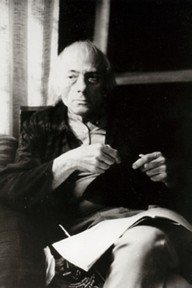Louis Faurer
Louis Faurer | |
|---|---|
 Louis Faurer, Hartsdale, 1971 | |
| Born | August 28, 1916 |
| Died | March 2, 2001 (aged 84) |
| Nationality | American |
| Known for | Photography |
Louis Faurer (August 28, 1916 – March 2, 2001) was an American fashion photographer and a master of candid or street photography. He was a quiet artist who never achieved the broad public recognition that his best-known contemporaries did; however, the significance and caliber of his work were lauded by insiders, among them Robert Frank, William Eggleston, and Edward Steichen, who included his work in the Museum of Modern Art exhibitions In and Out of Focus (1948) and The Family of Man (1955).
Life and career
Growing up in Philadelphia, Faurer showed an early aptitude for illustration. He bought his first camera in 1937 from the photographer Ben Somoroff. After a couple of jobs as a photographic technician, Faurer made his way to Manhattan and into the world of fashion photography. He quickly made contacts that stood him in good stead: Robert Frank, with whom he shared a darkroom/studio and fast friendship, and Walker Evans, whom he’d long admired, who introduced him to Alexander Liberman at Vogue. Faurer photographed for magazines including Junior Bazaar, Harper’s Bazaar, Vogue, Look, Life, Mademoiselle, and Glamour for more than twenty years. He complained that his work at Life involved too much travel, so he quit in the early 1950s. Most of the prints and negatives of his fashion work have probably been discarded, as Faurer stored them with a friend when he left the country in the late 1960s, then failed to reclaim them.
It is Faurer’s personal work from the '40s, '50s, and '60s for which he is best remembered. He photographed the streets of New York and Philadelphia, capturing the restless energy of urban life. His sensitive lens probed the great variety of the city's human face, especially "the lonely Times Square people for whom Faurer felt a deep sympathy."[1]
Faurer experimented with blur, grain, double exposures, sandwiched negatives, reflections, slow film speeds, and low lighting to achieve the effects he was seeking. As exacting in the darkroom as he was in the field, he was notorious for being a tireless perfectionist when it came to cropping and printing his work.
In the mid- and late 1960s Faurer experimented with hand-held 16mm Arriflex and Beaulieu movie cameras, filming in the streets of Manhattan, extending his still camera style into a cinematic medium. He also edited this footage.
Between 1969 and 1974 he lived and worked abroad, mostly in Paris. From the mid-’70s to the mid-’80s, Faurer taught at numerous art schools and universities, including the Parsons School of Design in New York City, the University of Virginia in Charlottesville, Yale University, The New School for Social Research and Stockton State College in New Jersey. He also received grants from the NEA and the Guggenheim.
Faurer’s first solo show was held at Helen Gee’s Limelight Gallery in 1959. In 1977 he had his second solo exhibition, at the Marlborough Gallery in Manhattan, followed by a 1981 exhibition at The Art Gallery at the University of Maryland. A posthumous show, first mounted at the Museum of Fine Arts, Houston, in 2002, traveled to several cities.
In 1984, while running to catch a city bus, Faurer was struck by a car and seriously injured. He never photographed again.
“I am in awe of the high point he can reach in a photograph such as Family, Times Square, at the center of New York in the center of our century. Perhaps no other American image stands comparison with Picasso’s Family of Saltimbanques, on their imagined European plane in 1905….Faurer stands and lives as a master of his medium.”[2] —Walter Hopps
Notes
- ^ 1. Letter from Robert Frank in deja-vu: a photography quarterly (Tokyo) 16 (spring 1994), p. 54.
- ^ 2. Louis Faurer: Photographs from Philadelphia and New York, 1937-1973. Edited by Edith A. Tonelli and John Gossage. Curated and texts by Louis Faurer and Walter Hopps. (University of Maryland Art Gallery, 1981), p. 12.
References
- Wilkes Tucker, Anne, Louis Faurer. London/New York: Merrell Publishers, 2002. ISBN 1-85894-165-2; ISBN 978-1-85894-165-3
- Louis Faurer: Photographs from Philadelphia and New York, 1937-1973. Edited by Edith A. Tonelli and John Gossage. Curated and texts by Louis Faurer and Walter Hopps. College Park, Maryland: University of Maryland Art Gallery, 1981.
- “Louis Faurer: Sometime in New York City.” deja-vu: a photography quarterly (Tokyo) 16 (spring 1994).
- Louis Faurer. Introduction by Martin Harrison. Notes by Stuart Alexander. Collection Photo Poche. Paris. Centre National de la Photographie, 1992.
- Livingston, Jane. The New York School: Photographs, 1936-1963. New York: Stewart, Tabori & Chang, 1992.
External links
- "Louis Faurer, Photographer Who Captured Compelling Images of the Street, Dies at 84," New York Times, March 12, 2001
- "The Lives They Lived: Gallery: Louis Faurer, B. 1916, Friends Through the Lens," New York Times, December 30, 2001
- MIA Collection of Photographs by Louis Faurer
- Museum of Contemporary Photography Collection
- The Metropolitan Museum of Art Collection
- "Elevated Subway on 3rd Avenue (looking at Tudor City, NY) c.1947"
